Comprehensive Marketing Analysis of Unilever Plc: A Detailed Report
VerifiedAdded on 2022/11/25
|11
|3211
|145
Report
AI Summary
This report provides a comprehensive analysis of Unilever Plc's marketing management strategies. It begins with a company background, followed by a macro-environmental analysis using the PESTEL framework, examining political, economic, social, technological, environmental, and legal factors impacting the business. The report then delves into a micro-environmental analysis, assessing the influence of customers, suppliers, competitors, employees, public, and market intermediaries. A competitive analysis is conducted, comparing Unilever Plc's strategies with those of its competitors, including a discussion of strategic groups and perceptual mapping. Finally, a SWOT analysis identifies the company's strengths, weaknesses, opportunities, and threats, offering insights into strategic decision-making. The report concludes by summarizing the key findings and their implications for Unilever Plc's marketing management.

Principles of Marketing
Management
Management
Paraphrase This Document
Need a fresh take? Get an instant paraphrase of this document with our AI Paraphraser

Contents
Principles of Marketing Management.........................................................................................1
Contents...........................................................................................................................................2
INTRODUCTION...........................................................................................................................1
MAIN BODY..................................................................................................................................1
Company Background.................................................................................................................1
Macro analysis.............................................................................................................................1
Micro analysis..............................................................................................................................3
Competitive analysis....................................................................................................................4
SWOT analysis............................................................................................................................6
CONCLUSION................................................................................................................................8
REFERENCES................................................................................................................................9
Principles of Marketing Management.........................................................................................1
Contents...........................................................................................................................................2
INTRODUCTION...........................................................................................................................1
MAIN BODY..................................................................................................................................1
Company Background.................................................................................................................1
Macro analysis.............................................................................................................................1
Micro analysis..............................................................................................................................3
Competitive analysis....................................................................................................................4
SWOT analysis............................................................................................................................6
CONCLUSION................................................................................................................................8
REFERENCES................................................................................................................................9
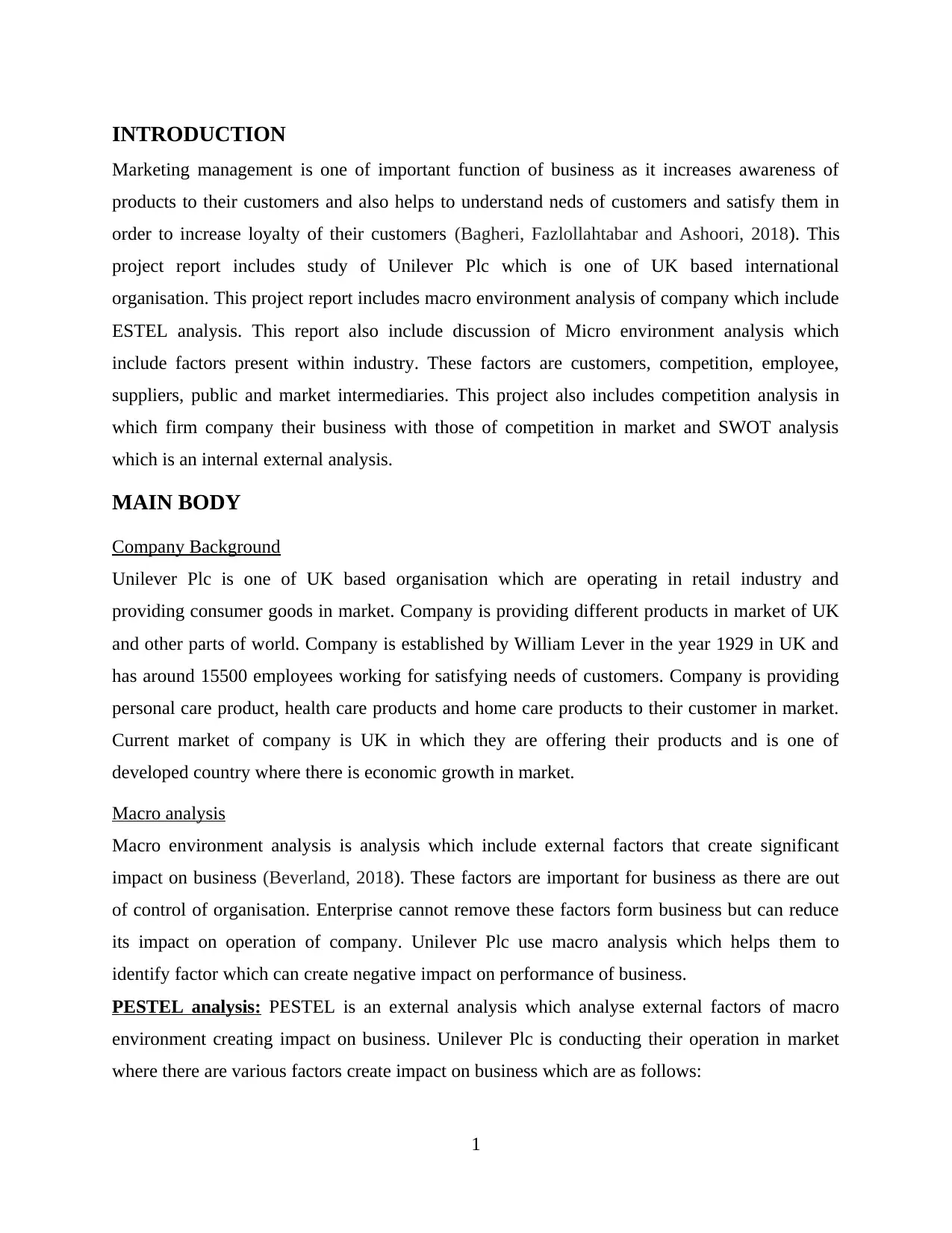
INTRODUCTION
Marketing management is one of important function of business as it increases awareness of
products to their customers and also helps to understand neds of customers and satisfy them in
order to increase loyalty of their customers (Bagheri, Fazlollahtabar and Ashoori, 2018). This
project report includes study of Unilever Plc which is one of UK based international
organisation. This project report includes macro environment analysis of company which include
ESTEL analysis. This report also include discussion of Micro environment analysis which
include factors present within industry. These factors are customers, competition, employee,
suppliers, public and market intermediaries. This project also includes competition analysis in
which firm company their business with those of competition in market and SWOT analysis
which is an internal external analysis.
MAIN BODY
Company Background
Unilever Plc is one of UK based organisation which are operating in retail industry and
providing consumer goods in market. Company is providing different products in market of UK
and other parts of world. Company is established by William Lever in the year 1929 in UK and
has around 15500 employees working for satisfying needs of customers. Company is providing
personal care product, health care products and home care products to their customer in market.
Current market of company is UK in which they are offering their products and is one of
developed country where there is economic growth in market.
Macro analysis
Macro environment analysis is analysis which include external factors that create significant
impact on business (Beverland, 2018). These factors are important for business as there are out
of control of organisation. Enterprise cannot remove these factors form business but can reduce
its impact on operation of company. Unilever Plc use macro analysis which helps them to
identify factor which can create negative impact on performance of business.
PESTEL analysis: PESTEL is an external analysis which analyse external factors of macro
environment creating impact on business. Unilever Plc is conducting their operation in market
where there are various factors create impact on business which are as follows:
1
Marketing management is one of important function of business as it increases awareness of
products to their customers and also helps to understand neds of customers and satisfy them in
order to increase loyalty of their customers (Bagheri, Fazlollahtabar and Ashoori, 2018). This
project report includes study of Unilever Plc which is one of UK based international
organisation. This project report includes macro environment analysis of company which include
ESTEL analysis. This report also include discussion of Micro environment analysis which
include factors present within industry. These factors are customers, competition, employee,
suppliers, public and market intermediaries. This project also includes competition analysis in
which firm company their business with those of competition in market and SWOT analysis
which is an internal external analysis.
MAIN BODY
Company Background
Unilever Plc is one of UK based organisation which are operating in retail industry and
providing consumer goods in market. Company is providing different products in market of UK
and other parts of world. Company is established by William Lever in the year 1929 in UK and
has around 15500 employees working for satisfying needs of customers. Company is providing
personal care product, health care products and home care products to their customer in market.
Current market of company is UK in which they are offering their products and is one of
developed country where there is economic growth in market.
Macro analysis
Macro environment analysis is analysis which include external factors that create significant
impact on business (Beverland, 2018). These factors are important for business as there are out
of control of organisation. Enterprise cannot remove these factors form business but can reduce
its impact on operation of company. Unilever Plc use macro analysis which helps them to
identify factor which can create negative impact on performance of business.
PESTEL analysis: PESTEL is an external analysis which analyse external factors of macro
environment creating impact on business. Unilever Plc is conducting their operation in market
where there are various factors create impact on business which are as follows:
1
⊘ This is a preview!⊘
Do you want full access?
Subscribe today to unlock all pages.

Trusted by 1+ million students worldwide
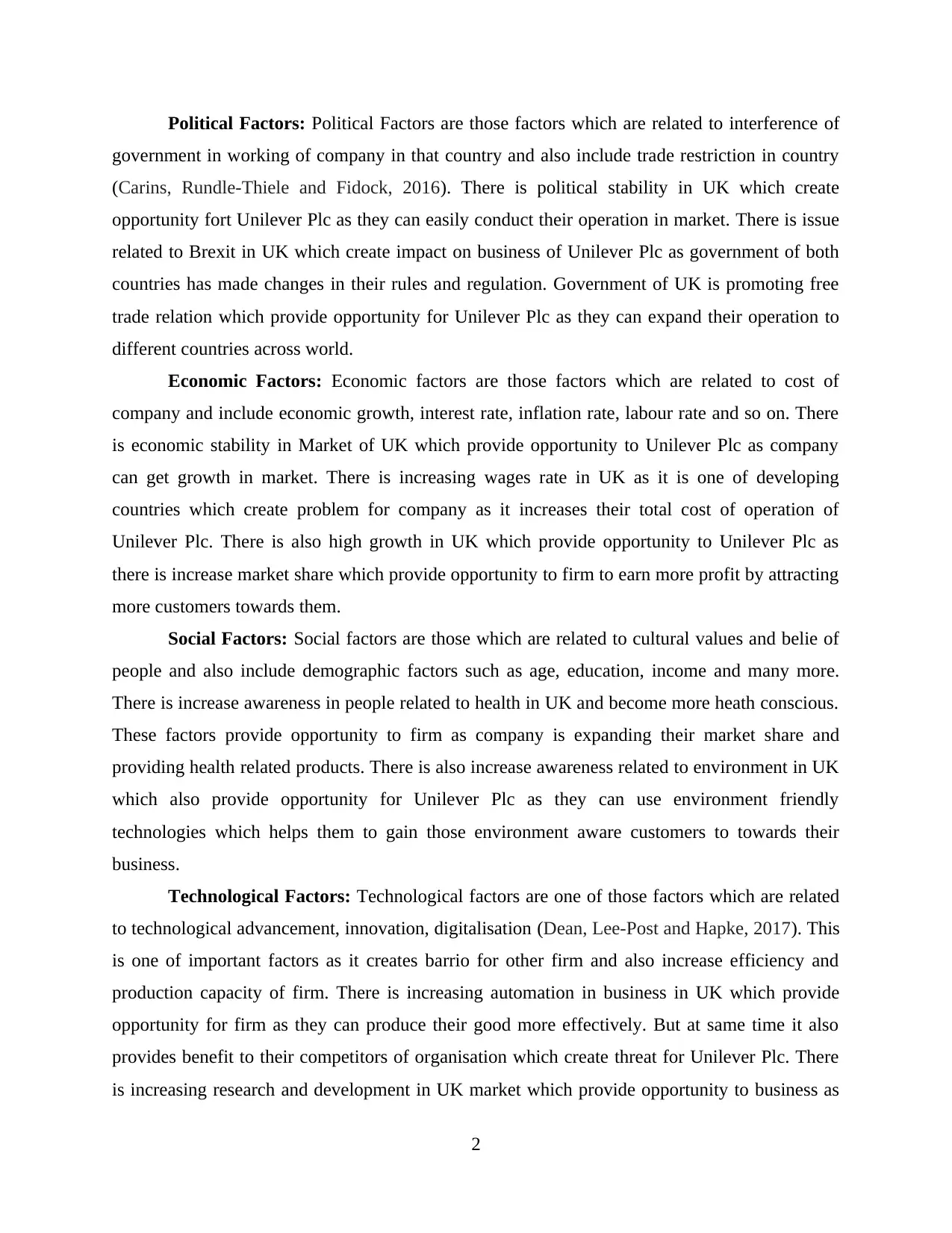
Political Factors: Political Factors are those factors which are related to interference of
government in working of company in that country and also include trade restriction in country
(Carins, Rundle-Thiele and Fidock, 2016). There is political stability in UK which create
opportunity fort Unilever Plc as they can easily conduct their operation in market. There is issue
related to Brexit in UK which create impact on business of Unilever Plc as government of both
countries has made changes in their rules and regulation. Government of UK is promoting free
trade relation which provide opportunity for Unilever Plc as they can expand their operation to
different countries across world.
Economic Factors: Economic factors are those factors which are related to cost of
company and include economic growth, interest rate, inflation rate, labour rate and so on. There
is economic stability in Market of UK which provide opportunity to Unilever Plc as company
can get growth in market. There is increasing wages rate in UK as it is one of developing
countries which create problem for company as it increases their total cost of operation of
Unilever Plc. There is also high growth in UK which provide opportunity to Unilever Plc as
there is increase market share which provide opportunity to firm to earn more profit by attracting
more customers towards them.
Social Factors: Social factors are those which are related to cultural values and belie of
people and also include demographic factors such as age, education, income and many more.
There is increase awareness in people related to health in UK and become more heath conscious.
These factors provide opportunity to firm as company is expanding their market share and
providing health related products. There is also increase awareness related to environment in UK
which also provide opportunity for Unilever Plc as they can use environment friendly
technologies which helps them to gain those environment aware customers to towards their
business.
Technological Factors: Technological factors are one of those factors which are related
to technological advancement, innovation, digitalisation (Dean, Lee-Post and Hapke, 2017). This
is one of important factors as it creates barrio for other firm and also increase efficiency and
production capacity of firm. There is increasing automation in business in UK which provide
opportunity for firm as they can produce their good more effectively. But at same time it also
provides benefit to their competitors of organisation which create threat for Unilever Plc. There
is increasing research and development in UK market which provide opportunity to business as
2
government in working of company in that country and also include trade restriction in country
(Carins, Rundle-Thiele and Fidock, 2016). There is political stability in UK which create
opportunity fort Unilever Plc as they can easily conduct their operation in market. There is issue
related to Brexit in UK which create impact on business of Unilever Plc as government of both
countries has made changes in their rules and regulation. Government of UK is promoting free
trade relation which provide opportunity for Unilever Plc as they can expand their operation to
different countries across world.
Economic Factors: Economic factors are those factors which are related to cost of
company and include economic growth, interest rate, inflation rate, labour rate and so on. There
is economic stability in Market of UK which provide opportunity to Unilever Plc as company
can get growth in market. There is increasing wages rate in UK as it is one of developing
countries which create problem for company as it increases their total cost of operation of
Unilever Plc. There is also high growth in UK which provide opportunity to Unilever Plc as
there is increase market share which provide opportunity to firm to earn more profit by attracting
more customers towards them.
Social Factors: Social factors are those which are related to cultural values and belie of
people and also include demographic factors such as age, education, income and many more.
There is increase awareness in people related to health in UK and become more heath conscious.
These factors provide opportunity to firm as company is expanding their market share and
providing health related products. There is also increase awareness related to environment in UK
which also provide opportunity for Unilever Plc as they can use environment friendly
technologies which helps them to gain those environment aware customers to towards their
business.
Technological Factors: Technological factors are one of those factors which are related
to technological advancement, innovation, digitalisation (Dean, Lee-Post and Hapke, 2017). This
is one of important factors as it creates barrio for other firm and also increase efficiency and
production capacity of firm. There is increasing automation in business in UK which provide
opportunity for firm as they can produce their good more effectively. But at same time it also
provides benefit to their competitors of organisation which create threat for Unilever Plc. There
is increasing research and development in UK market which provide opportunity to business as
2
Paraphrase This Document
Need a fresh take? Get an instant paraphrase of this document with our AI Paraphraser
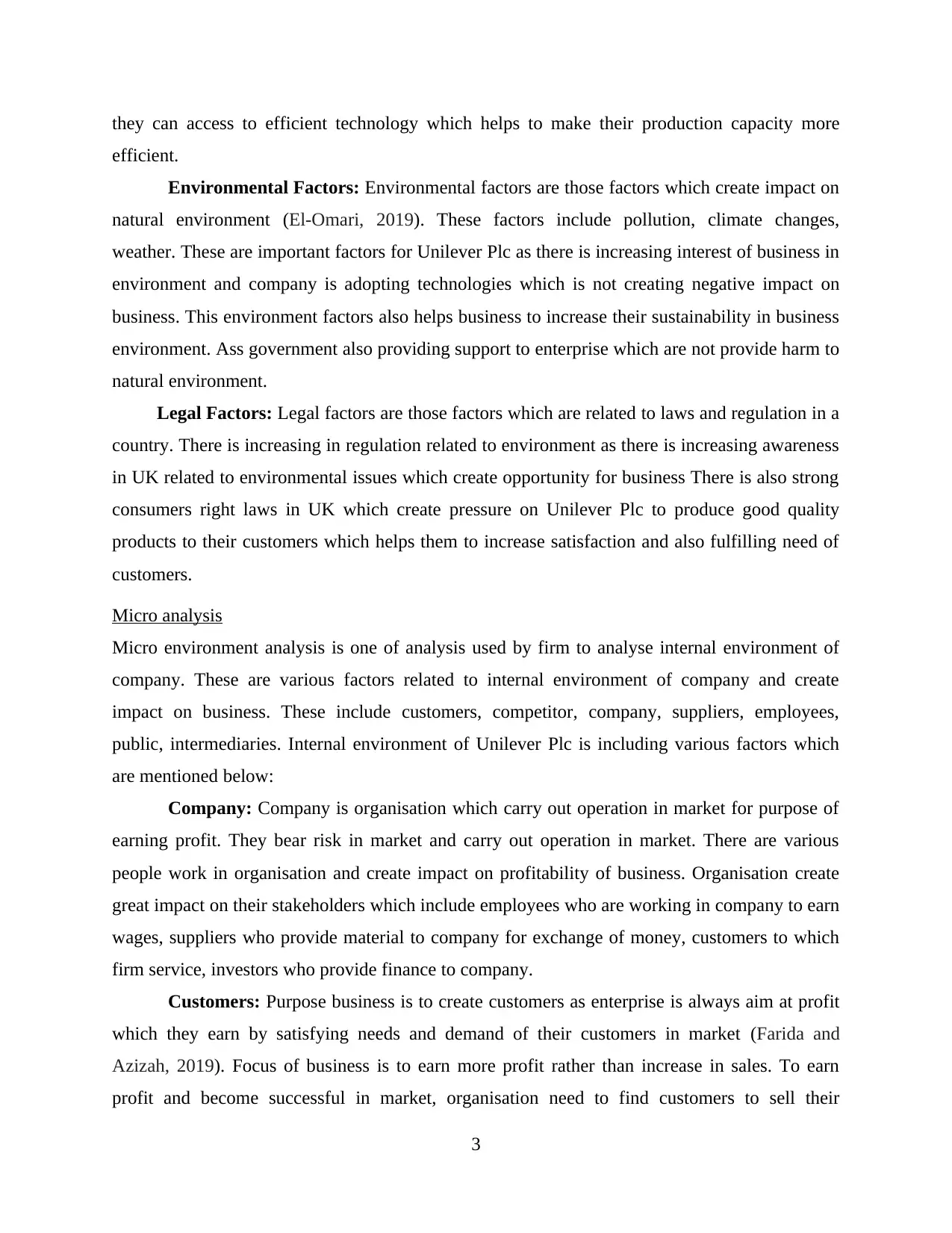
they can access to efficient technology which helps to make their production capacity more
efficient.
Environmental Factors: Environmental factors are those factors which create impact on
natural environment (El-Omari, 2019). These factors include pollution, climate changes,
weather. These are important factors for Unilever Plc as there is increasing interest of business in
environment and company is adopting technologies which is not creating negative impact on
business. This environment factors also helps business to increase their sustainability in business
environment. Ass government also providing support to enterprise which are not provide harm to
natural environment.
Legal Factors: Legal factors are those factors which are related to laws and regulation in a
country. There is increasing in regulation related to environment as there is increasing awareness
in UK related to environmental issues which create opportunity for business There is also strong
consumers right laws in UK which create pressure on Unilever Plc to produce good quality
products to their customers which helps them to increase satisfaction and also fulfilling need of
customers.
Micro analysis
Micro environment analysis is one of analysis used by firm to analyse internal environment of
company. These are various factors related to internal environment of company and create
impact on business. These include customers, competitor, company, suppliers, employees,
public, intermediaries. Internal environment of Unilever Plc is including various factors which
are mentioned below:
Company: Company is organisation which carry out operation in market for purpose of
earning profit. They bear risk in market and carry out operation in market. There are various
people work in organisation and create impact on profitability of business. Organisation create
great impact on their stakeholders which include employees who are working in company to earn
wages, suppliers who provide material to company for exchange of money, customers to which
firm service, investors who provide finance to company.
Customers: Purpose business is to create customers as enterprise is always aim at profit
which they earn by satisfying needs and demand of their customers in market (Farida and
Azizah, 2019). Focus of business is to earn more profit rather than increase in sales. To earn
profit and become successful in market, organisation need to find customers to sell their
3
efficient.
Environmental Factors: Environmental factors are those factors which create impact on
natural environment (El-Omari, 2019). These factors include pollution, climate changes,
weather. These are important factors for Unilever Plc as there is increasing interest of business in
environment and company is adopting technologies which is not creating negative impact on
business. This environment factors also helps business to increase their sustainability in business
environment. Ass government also providing support to enterprise which are not provide harm to
natural environment.
Legal Factors: Legal factors are those factors which are related to laws and regulation in a
country. There is increasing in regulation related to environment as there is increasing awareness
in UK related to environmental issues which create opportunity for business There is also strong
consumers right laws in UK which create pressure on Unilever Plc to produce good quality
products to their customers which helps them to increase satisfaction and also fulfilling need of
customers.
Micro analysis
Micro environment analysis is one of analysis used by firm to analyse internal environment of
company. These are various factors related to internal environment of company and create
impact on business. These include customers, competitor, company, suppliers, employees,
public, intermediaries. Internal environment of Unilever Plc is including various factors which
are mentioned below:
Company: Company is organisation which carry out operation in market for purpose of
earning profit. They bear risk in market and carry out operation in market. There are various
people work in organisation and create impact on profitability of business. Organisation create
great impact on their stakeholders which include employees who are working in company to earn
wages, suppliers who provide material to company for exchange of money, customers to which
firm service, investors who provide finance to company.
Customers: Purpose business is to create customers as enterprise is always aim at profit
which they earn by satisfying needs and demand of their customers in market (Farida and
Azizah, 2019). Focus of business is to earn more profit rather than increase in sales. To earn
profit and become successful in market, organisation need to find customers to sell their
3
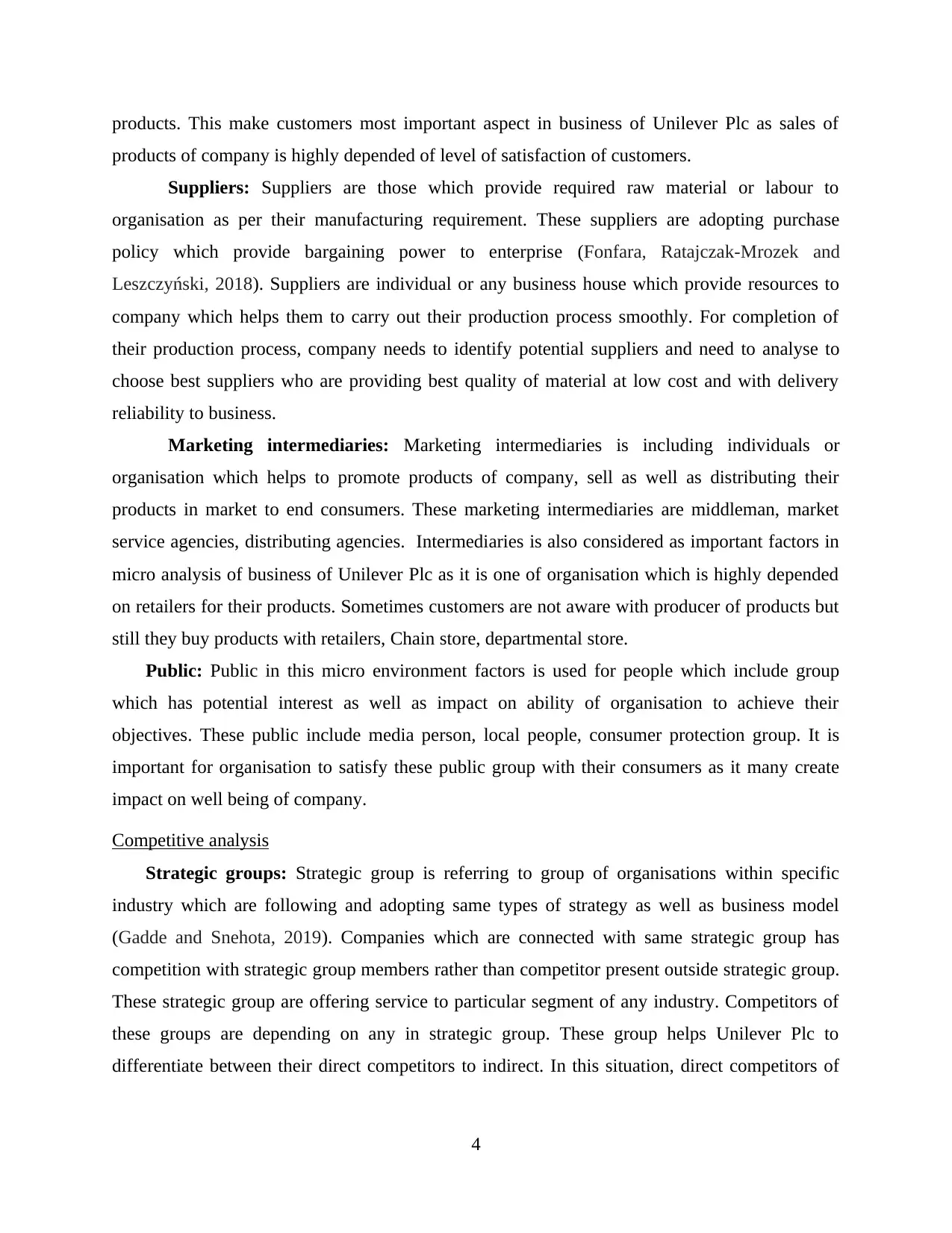
products. This make customers most important aspect in business of Unilever Plc as sales of
products of company is highly depended of level of satisfaction of customers.
Suppliers: Suppliers are those which provide required raw material or labour to
organisation as per their manufacturing requirement. These suppliers are adopting purchase
policy which provide bargaining power to enterprise (Fonfara, Ratajczak-Mrozek and
Leszczyński, 2018). Suppliers are individual or any business house which provide resources to
company which helps them to carry out their production process smoothly. For completion of
their production process, company needs to identify potential suppliers and need to analyse to
choose best suppliers who are providing best quality of material at low cost and with delivery
reliability to business.
Marketing intermediaries: Marketing intermediaries is including individuals or
organisation which helps to promote products of company, sell as well as distributing their
products in market to end consumers. These marketing intermediaries are middleman, market
service agencies, distributing agencies. Intermediaries is also considered as important factors in
micro analysis of business of Unilever Plc as it is one of organisation which is highly depended
on retailers for their products. Sometimes customers are not aware with producer of products but
still they buy products with retailers, Chain store, departmental store.
Public: Public in this micro environment factors is used for people which include group
which has potential interest as well as impact on ability of organisation to achieve their
objectives. These public include media person, local people, consumer protection group. It is
important for organisation to satisfy these public group with their consumers as it many create
impact on well being of company.
Competitive analysis
Strategic groups: Strategic group is referring to group of organisations within specific
industry which are following and adopting same types of strategy as well as business model
(Gadde and Snehota, 2019). Companies which are connected with same strategic group has
competition with strategic group members rather than competitor present outside strategic group.
These strategic group are offering service to particular segment of any industry. Competitors of
these groups are depending on any in strategic group. These group helps Unilever Plc to
differentiate between their direct competitors to indirect. In this situation, direct competitors of
4
products of company is highly depended of level of satisfaction of customers.
Suppliers: Suppliers are those which provide required raw material or labour to
organisation as per their manufacturing requirement. These suppliers are adopting purchase
policy which provide bargaining power to enterprise (Fonfara, Ratajczak-Mrozek and
Leszczyński, 2018). Suppliers are individual or any business house which provide resources to
company which helps them to carry out their production process smoothly. For completion of
their production process, company needs to identify potential suppliers and need to analyse to
choose best suppliers who are providing best quality of material at low cost and with delivery
reliability to business.
Marketing intermediaries: Marketing intermediaries is including individuals or
organisation which helps to promote products of company, sell as well as distributing their
products in market to end consumers. These marketing intermediaries are middleman, market
service agencies, distributing agencies. Intermediaries is also considered as important factors in
micro analysis of business of Unilever Plc as it is one of organisation which is highly depended
on retailers for their products. Sometimes customers are not aware with producer of products but
still they buy products with retailers, Chain store, departmental store.
Public: Public in this micro environment factors is used for people which include group
which has potential interest as well as impact on ability of organisation to achieve their
objectives. These public include media person, local people, consumer protection group. It is
important for organisation to satisfy these public group with their consumers as it many create
impact on well being of company.
Competitive analysis
Strategic groups: Strategic group is referring to group of organisations within specific
industry which are following and adopting same types of strategy as well as business model
(Gadde and Snehota, 2019). Companies which are connected with same strategic group has
competition with strategic group members rather than competitor present outside strategic group.
These strategic group are offering service to particular segment of any industry. Competitors of
these groups are depending on any in strategic group. These group helps Unilever Plc to
differentiate between their direct competitors to indirect. In this situation, direct competitors of
4
⊘ This is a preview!⊘
Do you want full access?
Subscribe today to unlock all pages.

Trusted by 1+ million students worldwide

Unilever Plc are those who are members of strategic group. These strategic group results in
industry to more innovation, quality products, low profitability and decreased prices.
Perceptual mapping: Perceptual mapping is one of visual representation of brand and
service to allow them to stand in competitors (Liu and Atuahene-Gima, 2018). This is one of
competitive analysis framework which include two basis including prices and quality. Unilever
Plc need to select one of attribute among prices and quality and need to positioned these bases.
These also utilise inputs of consumers in order to understand brand, products and service from
customers view.
Company Strength Weakness
Unilever Plc Unilever Plc has strong brand
in market in industry of
consumer goods.
Company is offering wide
range of products to their
customers as has broad
product mix.
Unilever Plc is predicting at
large scale at providing their
service in international
market which provide them
benefit of economies of scale.
Company also has global
presence in market which
increase their brand values.
Company is providing
imitable products in
market which are easily
copied by their
competitors.
There are wide range of
products offered by
Unilever Plc but there is
not diversification in
business.
Business of company is
depended on retailers as
they are one who directly
interact with customers.
Nestle Nestle has reputed brand in
market and company is
providing highly qualitative
products in market to their
customers. They also has
globally providing their
services (Solimun and
There is prices fluctuation
by giant retailers in this
industry which create
impact on pricing of
company’s products.
Company is offering
diversified products to
5
industry to more innovation, quality products, low profitability and decreased prices.
Perceptual mapping: Perceptual mapping is one of visual representation of brand and
service to allow them to stand in competitors (Liu and Atuahene-Gima, 2018). This is one of
competitive analysis framework which include two basis including prices and quality. Unilever
Plc need to select one of attribute among prices and quality and need to positioned these bases.
These also utilise inputs of consumers in order to understand brand, products and service from
customers view.
Company Strength Weakness
Unilever Plc Unilever Plc has strong brand
in market in industry of
consumer goods.
Company is offering wide
range of products to their
customers as has broad
product mix.
Unilever Plc is predicting at
large scale at providing their
service in international
market which provide them
benefit of economies of scale.
Company also has global
presence in market which
increase their brand values.
Company is providing
imitable products in
market which are easily
copied by their
competitors.
There are wide range of
products offered by
Unilever Plc but there is
not diversification in
business.
Business of company is
depended on retailers as
they are one who directly
interact with customers.
Nestle Nestle has reputed brand in
market and company is
providing highly qualitative
products in market to their
customers. They also has
globally providing their
services (Solimun and
There is prices fluctuation
by giant retailers in this
industry which create
impact on pricing of
company’s products.
Company is offering
diversified products to
5
Paraphrase This Document
Need a fresh take? Get an instant paraphrase of this document with our AI Paraphraser

Fernandes, 2018).
Company is offering
diversified products to their
customers.
Company has also good
relationship with their
customers and has different
brands under their name.
Company is also adopting
environmental sustainability
process in market.
their customer which
make it difficult for them
to manage.
Company has also face
social criticism which
create impact on image of
their organisation as some
products of companies are
unhealthy.
SWOT analysis
SWOT analysis ins an internal external analysis used by firm for identification of threat and
weakness of firm and also to identify factors which create opportunity for them in market
(Yurdakul and Bozdağ, 2018). Identification of these factors which create negative impact over
business helps them to develop strategies to overcome of its negative impact. SWOT analysis of
Unilever Plc is also helping them in overcome for problems of business are as follows:
Strength Weakness
Unilever Plc is large organisation
which has strong brand in markets
which are providing consumer good to
their customers. These strong brands
allow organisation to penetrate market
and can compete with other market
players within industry.
Unilever plc has broad product mix
which is reflecting growth of company
in market. Company is offering wide
range of product which increase their
provide and growth in market of UK.
Company is offering imitable products
in market which create problems for
them as these products are easily copied
by other brands. Unilever Plc is
focusing on providing process of
product development process but still
there is problems with their products as
these can be easily copied by other
market players.
There is limited diversification in
market as company is operating in
consumer goods industry. Although
6
Company is offering
diversified products to their
customers.
Company has also good
relationship with their
customers and has different
brands under their name.
Company is also adopting
environmental sustainability
process in market.
their customer which
make it difficult for them
to manage.
Company has also face
social criticism which
create impact on image of
their organisation as some
products of companies are
unhealthy.
SWOT analysis
SWOT analysis ins an internal external analysis used by firm for identification of threat and
weakness of firm and also to identify factors which create opportunity for them in market
(Yurdakul and Bozdağ, 2018). Identification of these factors which create negative impact over
business helps them to develop strategies to overcome of its negative impact. SWOT analysis of
Unilever Plc is also helping them in overcome for problems of business are as follows:
Strength Weakness
Unilever Plc is large organisation
which has strong brand in markets
which are providing consumer good to
their customers. These strong brands
allow organisation to penetrate market
and can compete with other market
players within industry.
Unilever plc has broad product mix
which is reflecting growth of company
in market. Company is offering wide
range of product which increase their
provide and growth in market of UK.
Company is offering imitable products
in market which create problems for
them as these products are easily copied
by other brands. Unilever Plc is
focusing on providing process of
product development process but still
there is problems with their products as
these can be easily copied by other
market players.
There is limited diversification in
market as company is operating in
consumer goods industry. Although
6
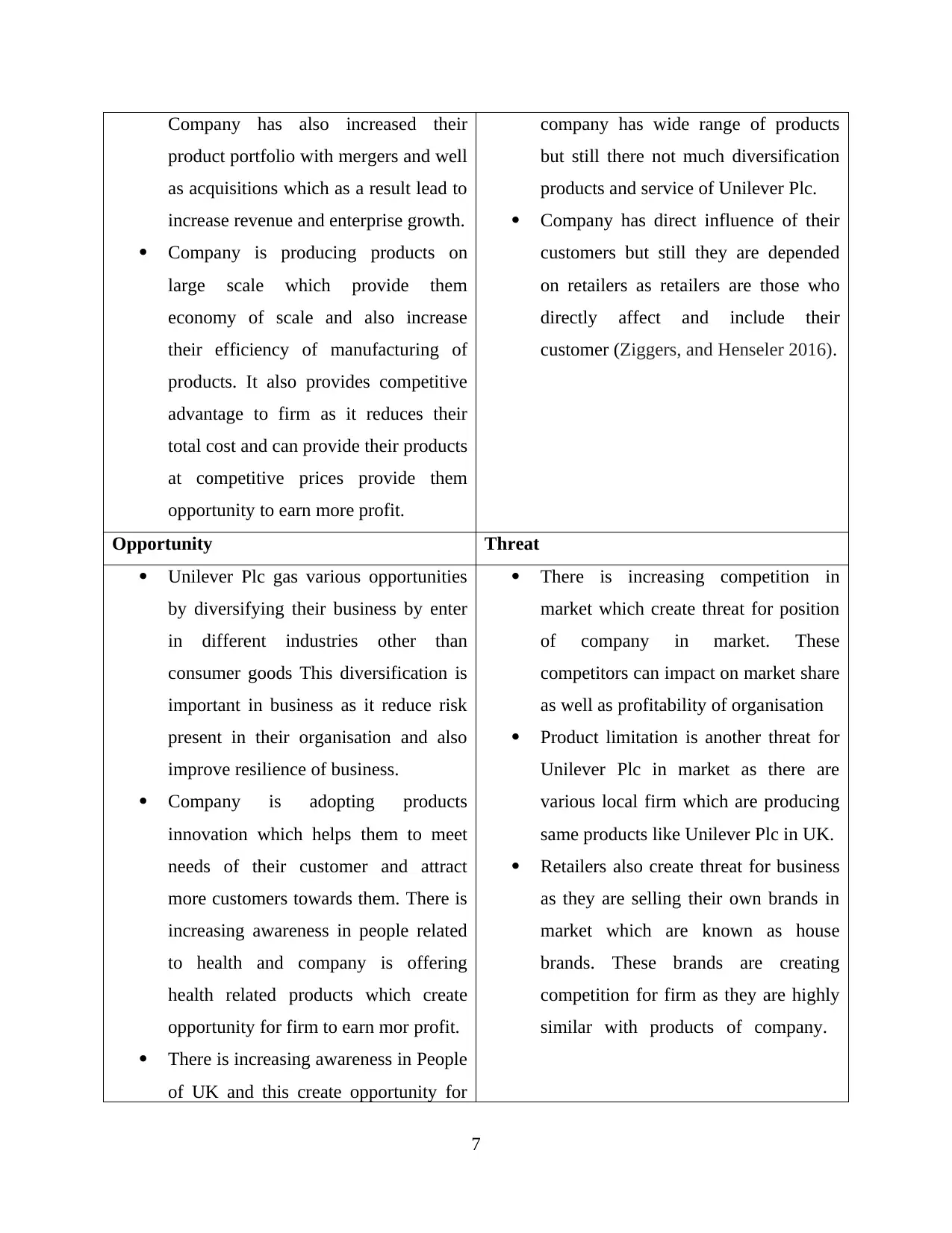
Company has also increased their
product portfolio with mergers and well
as acquisitions which as a result lead to
increase revenue and enterprise growth.
Company is producing products on
large scale which provide them
economy of scale and also increase
their efficiency of manufacturing of
products. It also provides competitive
advantage to firm as it reduces their
total cost and can provide their products
at competitive prices provide them
opportunity to earn more profit.
company has wide range of products
but still there not much diversification
products and service of Unilever Plc.
Company has direct influence of their
customers but still they are depended
on retailers as retailers are those who
directly affect and include their
customer (Ziggers, and Henseler 2016).
Opportunity Threat
Unilever Plc gas various opportunities
by diversifying their business by enter
in different industries other than
consumer goods This diversification is
important in business as it reduce risk
present in their organisation and also
improve resilience of business.
Company is adopting products
innovation which helps them to meet
needs of their customer and attract
more customers towards them. There is
increasing awareness in people related
to health and company is offering
health related products which create
opportunity for firm to earn mor profit.
There is increasing awareness in People
of UK and this create opportunity for
There is increasing competition in
market which create threat for position
of company in market. These
competitors can impact on market share
as well as profitability of organisation
Product limitation is another threat for
Unilever Plc in market as there are
various local firm which are producing
same products like Unilever Plc in UK.
Retailers also create threat for business
as they are selling their own brands in
market which are known as house
brands. These brands are creating
competition for firm as they are highly
similar with products of company.
7
product portfolio with mergers and well
as acquisitions which as a result lead to
increase revenue and enterprise growth.
Company is producing products on
large scale which provide them
economy of scale and also increase
their efficiency of manufacturing of
products. It also provides competitive
advantage to firm as it reduces their
total cost and can provide their products
at competitive prices provide them
opportunity to earn more profit.
company has wide range of products
but still there not much diversification
products and service of Unilever Plc.
Company has direct influence of their
customers but still they are depended
on retailers as retailers are those who
directly affect and include their
customer (Ziggers, and Henseler 2016).
Opportunity Threat
Unilever Plc gas various opportunities
by diversifying their business by enter
in different industries other than
consumer goods This diversification is
important in business as it reduce risk
present in their organisation and also
improve resilience of business.
Company is adopting products
innovation which helps them to meet
needs of their customer and attract
more customers towards them. There is
increasing awareness in people related
to health and company is offering
health related products which create
opportunity for firm to earn mor profit.
There is increasing awareness in People
of UK and this create opportunity for
There is increasing competition in
market which create threat for position
of company in market. These
competitors can impact on market share
as well as profitability of organisation
Product limitation is another threat for
Unilever Plc in market as there are
various local firm which are producing
same products like Unilever Plc in UK.
Retailers also create threat for business
as they are selling their own brands in
market which are known as house
brands. These brands are creating
competition for firm as they are highly
similar with products of company.
7
⊘ This is a preview!⊘
Do you want full access?
Subscribe today to unlock all pages.

Trusted by 1+ million students worldwide

firm as firm can attract these customers
by adopting environment friendly
production process. This also increase
sustainability of business in market.
CONCLUSION
From above mentioned project report it can be concluded that marketing management is one
of important function of business which helps them to attract more customers and also increase
sales of business. A business can use different tool in order to overcome of factors which can
create negative impact on their operation. These analyses include macro environment analysis
and micro environment analysis. Micro environment analysis is one which helps to create
negative impact on business and are present inside business whereas macro environment analysis
is one which include factor present outside business. There are different some other analyse
include competitor’s analysis which is used by firm to analyse competitors in market and to
understand their strength and weakness. Company also use SWOT analysis which is used to
identify strength and weakness of business and also identify opportunity and threat.
8
by adopting environment friendly
production process. This also increase
sustainability of business in market.
CONCLUSION
From above mentioned project report it can be concluded that marketing management is one
of important function of business which helps them to attract more customers and also increase
sales of business. A business can use different tool in order to overcome of factors which can
create negative impact on their operation. These analyses include macro environment analysis
and micro environment analysis. Micro environment analysis is one which helps to create
negative impact on business and are present inside business whereas macro environment analysis
is one which include factor present outside business. There are different some other analyse
include competitor’s analysis which is used by firm to analyse competitors in market and to
understand their strength and weakness. Company also use SWOT analysis which is used to
identify strength and weakness of business and also identify opportunity and threat.
8
Paraphrase This Document
Need a fresh take? Get an instant paraphrase of this document with our AI Paraphraser
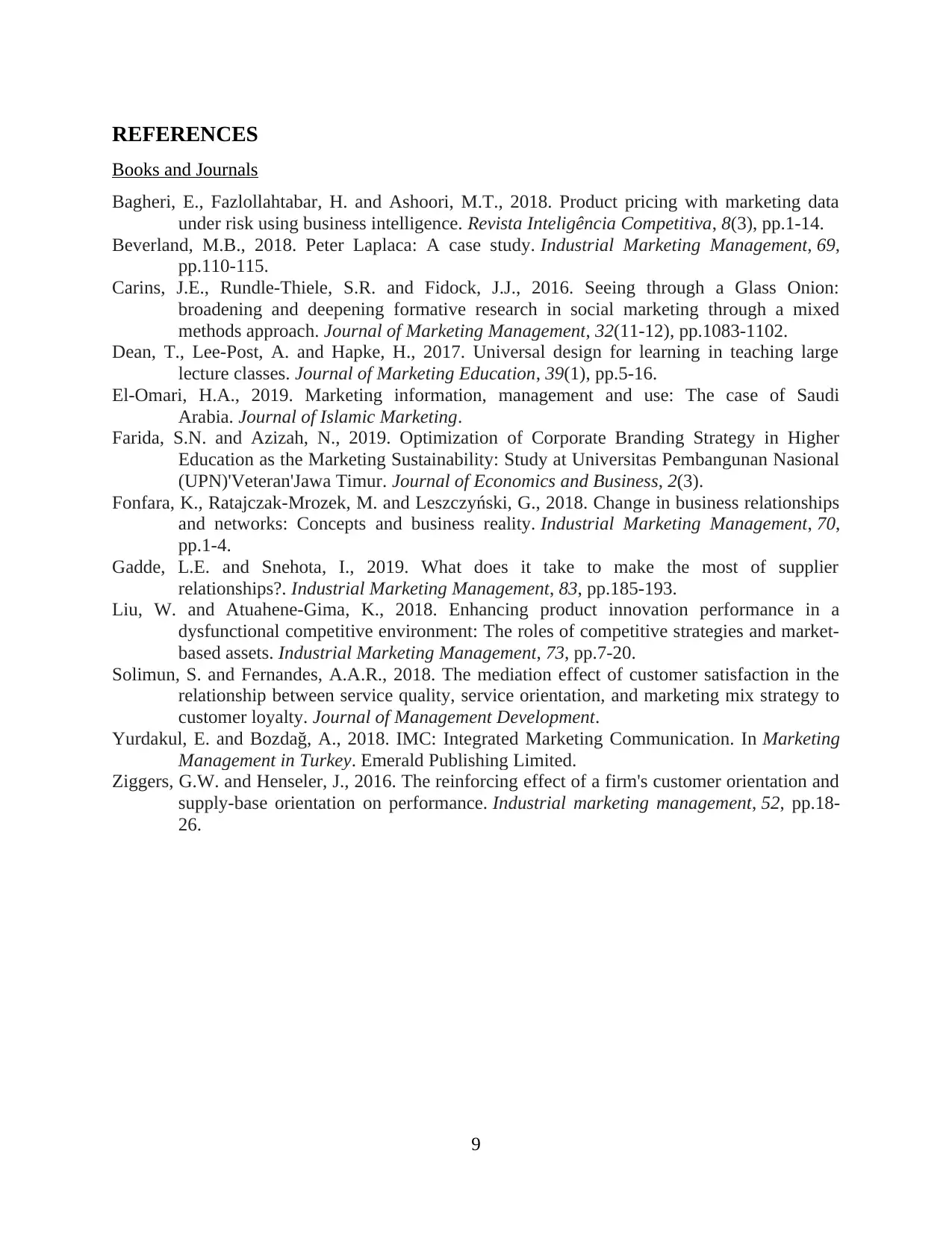
REFERENCES
Books and Journals
Bagheri, E., Fazlollahtabar, H. and Ashoori, M.T., 2018. Product pricing with marketing data
under risk using business intelligence. Revista Inteligência Competitiva, 8(3), pp.1-14.
Beverland, M.B., 2018. Peter Laplaca: A case study. Industrial Marketing Management, 69,
pp.110-115.
Carins, J.E., Rundle-Thiele, S.R. and Fidock, J.J., 2016. Seeing through a Glass Onion:
broadening and deepening formative research in social marketing through a mixed
methods approach. Journal of Marketing Management, 32(11-12), pp.1083-1102.
Dean, T., Lee-Post, A. and Hapke, H., 2017. Universal design for learning in teaching large
lecture classes. Journal of Marketing Education, 39(1), pp.5-16.
El-Omari, H.A., 2019. Marketing information, management and use: The case of Saudi
Arabia. Journal of Islamic Marketing.
Farida, S.N. and Azizah, N., 2019. Optimization of Corporate Branding Strategy in Higher
Education as the Marketing Sustainability: Study at Universitas Pembangunan Nasional
(UPN)'Veteran'Jawa Timur. Journal of Economics and Business, 2(3).
Fonfara, K., Ratajczak-Mrozek, M. and Leszczyński, G., 2018. Change in business relationships
and networks: Concepts and business reality. Industrial Marketing Management, 70,
pp.1-4.
Gadde, L.E. and Snehota, I., 2019. What does it take to make the most of supplier
relationships?. Industrial Marketing Management, 83, pp.185-193.
Liu, W. and Atuahene-Gima, K., 2018. Enhancing product innovation performance in a
dysfunctional competitive environment: The roles of competitive strategies and market-
based assets. Industrial Marketing Management, 73, pp.7-20.
Solimun, S. and Fernandes, A.A.R., 2018. The mediation effect of customer satisfaction in the
relationship between service quality, service orientation, and marketing mix strategy to
customer loyalty. Journal of Management Development.
Yurdakul, E. and Bozdağ, A., 2018. IMC: Integrated Marketing Communication. In Marketing
Management in Turkey. Emerald Publishing Limited.
Ziggers, G.W. and Henseler, J., 2016. The reinforcing effect of a firm's customer orientation and
supply-base orientation on performance. Industrial marketing management, 52, pp.18-
26.
9
Books and Journals
Bagheri, E., Fazlollahtabar, H. and Ashoori, M.T., 2018. Product pricing with marketing data
under risk using business intelligence. Revista Inteligência Competitiva, 8(3), pp.1-14.
Beverland, M.B., 2018. Peter Laplaca: A case study. Industrial Marketing Management, 69,
pp.110-115.
Carins, J.E., Rundle-Thiele, S.R. and Fidock, J.J., 2016. Seeing through a Glass Onion:
broadening and deepening formative research in social marketing through a mixed
methods approach. Journal of Marketing Management, 32(11-12), pp.1083-1102.
Dean, T., Lee-Post, A. and Hapke, H., 2017. Universal design for learning in teaching large
lecture classes. Journal of Marketing Education, 39(1), pp.5-16.
El-Omari, H.A., 2019. Marketing information, management and use: The case of Saudi
Arabia. Journal of Islamic Marketing.
Farida, S.N. and Azizah, N., 2019. Optimization of Corporate Branding Strategy in Higher
Education as the Marketing Sustainability: Study at Universitas Pembangunan Nasional
(UPN)'Veteran'Jawa Timur. Journal of Economics and Business, 2(3).
Fonfara, K., Ratajczak-Mrozek, M. and Leszczyński, G., 2018. Change in business relationships
and networks: Concepts and business reality. Industrial Marketing Management, 70,
pp.1-4.
Gadde, L.E. and Snehota, I., 2019. What does it take to make the most of supplier
relationships?. Industrial Marketing Management, 83, pp.185-193.
Liu, W. and Atuahene-Gima, K., 2018. Enhancing product innovation performance in a
dysfunctional competitive environment: The roles of competitive strategies and market-
based assets. Industrial Marketing Management, 73, pp.7-20.
Solimun, S. and Fernandes, A.A.R., 2018. The mediation effect of customer satisfaction in the
relationship between service quality, service orientation, and marketing mix strategy to
customer loyalty. Journal of Management Development.
Yurdakul, E. and Bozdağ, A., 2018. IMC: Integrated Marketing Communication. In Marketing
Management in Turkey. Emerald Publishing Limited.
Ziggers, G.W. and Henseler, J., 2016. The reinforcing effect of a firm's customer orientation and
supply-base orientation on performance. Industrial marketing management, 52, pp.18-
26.
9
1 out of 11
Related Documents
Your All-in-One AI-Powered Toolkit for Academic Success.
+13062052269
info@desklib.com
Available 24*7 on WhatsApp / Email
![[object Object]](/_next/static/media/star-bottom.7253800d.svg)
Unlock your academic potential
Copyright © 2020–2025 A2Z Services. All Rights Reserved. Developed and managed by ZUCOL.





